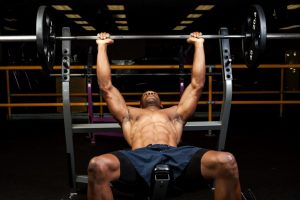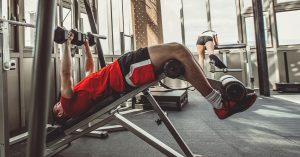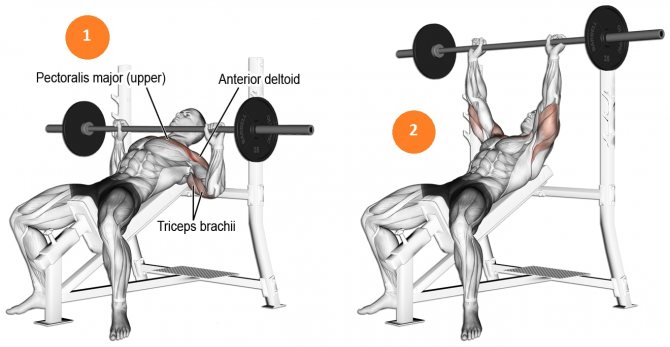What muscles work on the incline bench press
The incline bench press is considered one of the basic and key techniques for pumping and increasing the relief of the chest segment muscles. The most popular modifications are the press at an angle of 30 and 45 degrees, which distribute the load on the upper chest muscles. For beginners, the barbell press is best performed with an empty bar, without weight, under the supervision of a trainer. This will secure the correct bench press parameters.
- Main muscle group : pectorals
- Additional group: front serrated, rhomboid and lower trapezium bundles, rotators of the shoulder, biceps, triceps, muscles abdomen and buttocks, latissimus dorsi
- Degree of difficulty: medium
- Type of load: Basic, multi-joint
Technique
Load distribution
- Pressing the bar at an angle of 30 degrees loads mostly the muscle group of the middle segment of the chest and to some extent the upper part.
- A 45 degree tilt of the bench engages the upper area.
- To pump the lower muscle group of the chest, the bench press is performed in a downward incline modification.
The position of the elbows.
When the elbows are extended to the sides, it decreases triceps activity, and the work of the pectoral group of muscles (which is pumped in the exercise) increases. It is permissible in the lower maximum of the press, the elbows lead to the body and spread to the sides.
Variants of hand placement
• Narrow grip. To reduce the level of load on the chest segment and increase the work of the triceps muscle and the front delta bundles, grasp the bar with a narrow grip. The range of motion with a narrow grip is maximum.
• Wide stance. For maximum upper and middle pectoral pumping, use a wide arm stance on the bar. This modification will reduce the range of motion.
Technique Modifications
• Press with reverse grip.
• Modification of the press at an angle on the Smith bench.
• Use of dumbbells.
• Corner bench press in a power rack.

Practical nuances and aspects
To maximize the results of the incline bench press, use the following tips:
• The emphasis is not on weight, but on technique execution. It is better to choose a lighter working weight with which you will feel comfortable.
• Place your heels or whole feet on the floor. This will increase your hold, stability and support.
• Points of contact between the body and the bench: head, both shoulders and shoulder blades, sacrum.
• Maintain a natural arch in your back during the bench press and keep your shoulder blades drawn together to minimize the risk of injury.
• The higher the angle, the wider the grip.
• Lower the bar firmly into the collarbone, but do not place the bar on your chest. In this case, a slight retraction of the head back is quite acceptable.
• Lower the widow’s barbell more slowly than raising it.
• At the bottom of the exercise, hold your forearms upright.
• Damp inertia to prevent injury.
• When you lie down on the bench, arch your spine and push your chest forward.
Bench press in the general training scheme

First, a basic general muscle workout is performed, and only after that do they begin to load isolated segments of the pectoral muscle group. The incline press is done after a basic workout, for example, the classic bench press technique, push-ups on the uneven bars.
Sequence of execution
1. Set the degree of inclination of the bench depending on which muscle segment you want to pump. 2. Install the barbell and load it with a working weight. Remember to use the clamps on both ends of the projectile. If you’re a beginner, do an empty bar press. 3. Starting position: lying on the bench, hold the bar with a straight grip over the body. 4. The bar should only be supported by your palms, and place your thumb on top of it. 5. As you inhale, slowly and slowly lower the bar so that it touches the upper chest segment. 6. Straining your muscles, fix the position for 1-2 seconds. 7. While exhaling, use the muscles of the upper chest segment to squeeze the barbell and return to the starting position. 8. Do not throw the projectile on the chest, but do not push it up uncontrollably. Maintain a fluid and moderate pace throughout the exercise. 9. Repeat the 45-degree barbell press the desired number of times.
Major mistakes
• Incorrect bench angle. A tilt angle of more than 60 degrees will shift the focus to deltas. • Tearing off the pelvis and head from the bench, excessive arching of the back in the lumbar and thoracic regions. This position puts the load on the shoulders rather than on the chest. • The lowering point of the barbell is slightly higher than during the bench press. Throwing a projectile at the collarbone is fraught with bone injuries. The correct point is found empirically: at the lowest point you need to keep your forearms perpendicular to the floor surface. • Squeezing the bar up to straight arms. When the arms are fully extended, the load is redistributed not to the pectoral muscles, but to the triceps of the shoulder. Therefore, it is important to keep the elbows slightly bent. • The projectile should be lowered and squeezed out at an angle. Vertical movement puts extra stress on the shoulder muscles, which increases the risk of injury. • In the case of heavy work, it is recommended to have a belayer. • Number of repetitions: 3 sets of 10-12 reps • Weight: The working weight is selected such as to repeat the press on the bench 10-12 times
Number of repetitions
: 3 sets of 10-12 reps
Weight
: The working weight is selected such as to repeat the bench press 10- 12 times
How to find out the angle of the roof slope
There is a direct relationship between the slope of the roof slopes and the snow load. If the angle of inclination of the roof is less than 25 degrees, then the snow load factor is 1, and at angles varying from 25 to 60 degrees, then this factor increases to 1.25. A roof with a large angle of inclination will not be subject to snow loads at all, so they are not taken into account in the calculations.
To determine the angle of inclination of the roof, you need to use the Bradis table and a simple technique: the height of the roof structure is divided by the length of the gable, divided by two, after which it remains to find the table the angle that corresponds to the result obtained.
The height of the roof in the ridge is determined as follows:
- The first step is to calculate the span width;
- The resulting value is divided by 2;
- The result of the previous calculation is multiplied by a coefficient corresponding to a certain angle of inclination.
For example, the implementation of such a calculation method looks like this: with a width a building equal to 8 meters and a 25-degree roof slope, the design factor is 0.47. As a result of the substitution of values, an expression of the following form is obtained: 4×0.47 = 1.88 m. The resulting value is the height of the roof, corresponding to the available initial data.

Bench press at an angle video exercise
Brief conclusions
The barbell press on an incline bench is considered basic for improving the muscles of the upper segment of the body, the formation of a wide and powerful chest. Anatomically, the technique is similar to push-ups from the floor, but the use of a barbell allows you to use additional weight.
The correct execution of the incline bench press technique assumes that the feet are pressed to the floor, the shoulder blades are brought together, and a minimum deflection is maintained in the back. The pelvis is pressed against the support bench. The bar should be lowered diagonally, and at the lowest point of the amplitude, do not lower it all the way to the collarbone.
